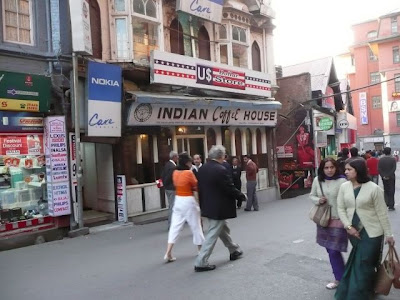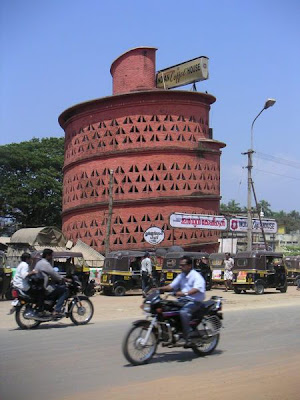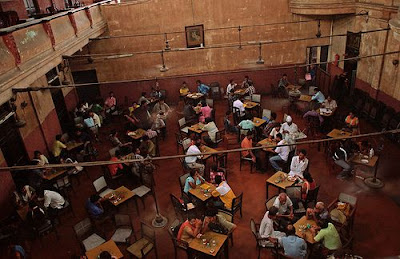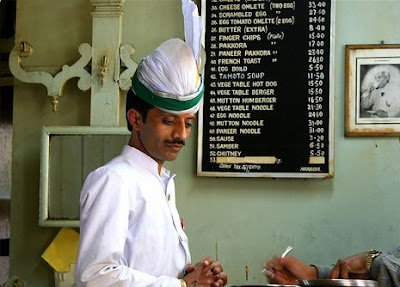Long time since, I added to the trivia... so here goes!
...Long before Semco became a corporate benchmark for "Managing Without Managers - a participatory industrial democracy... and Ricardo Semler's book Maverick became a runaway bestseller...
....And long before the Argentinian Workers' Cooperatives started taking over the abondoned workplaces - (this phenomenon requires a separate post.. will do that in time to come...) - something similar happened in India in 1957.
But some more trivia before that...
Long long time back, in the 17th century, Baba Budan smuggled the seven coffee bean seeds ("strapped to his chest" the legend tells us) from Yemen in the 16th century, and planted them on the Chandragiri hills of Mysore State. Over the next couple of centuries, coffee had gradually become the drink of the elites (Mughals and later, British) as well as of the ordinary families in southern India. The first coffee house opened in Kolkata after the battle of Plassy in 1780, soon to be followed by the Madras Coffee House. Soon coffee drinking became a "tradition" in India, and even became a staple drink for many families in southern India.

The Indian Coffee House(s) were promoted by the Indian Coffee Board during the British Rule during the 40s. Soon these became the meeting place for the poets, artistes, literati and people from the world of art and culture. ICHs Kolkata (erstwhile Calcutta) was frequented by figures ranging from Rabindranath Tagore to Subhash Chandra Bose... and later, from Manna Dey to Amartya Sen.
In the 1950s, however, the business was not doing well, and the Indian Coffee Board decided to close down the Coffee Houses. And that marked the beginning of a unique cooperative venture....
The Indian Coffee House. Under the leadership of the communist leader AK Gopalan, the dismissed workers took over the place to run without any management. The first Indian Coffee Workers Co-Operative Society was founded in Bangalore on August 19, 1957. The first Indian Coffee House was opened in New Delhi on October 27, 1957...

The self-managed India Coffee Houses proliferated. Today, there are around 50 of them across India, managed by 13 cooperative societies. These societies are governed by managing committees elected from the employees. There is also a federation of the co-operative societies as the national umbrella organisation to lead these socities.
But times have changed, and so have the Indian Coffee Houses. Some have got replaced by Caffe Coffee Days and Baristas, some have just gone plain bankrupt, and some have lost their old clientele and aura...
Some tributes to this vanishing institution:
A Mutiner reflects on the old nostalgia:
"
It would be a lie to say that I don’t miss that coffee house. An old dingy place with ceiling like a dome. The cheap wooden tables that were colored to give an impression of mahogany. Those two big glass jars at the managers desk. The waiters with the long pagdis. The manager who would return even fifty paise of your change but would never smile. The orders that would take exactly three hundred seconds to appear on your tables. The always present group of oldies, all of whom looked like communist poets or war veterans or editors of some old and forgotten local newspapers and their tables filled with three tea-cups (rather glasses) per person with the occasional one or two plates of egg pakodas. The fact that they were always there made me think that they owned the place, but now I realize that they were there because that was the only place that had not grown younger as they grew older. The Indian coffee house had grown older with them, with time it had become a little outdated, lost a little of its old shine and was stripped of most or all of its utility, just like them. Its all changed now with the Coffee Day standing in its place. Not that this change isn’t good or anything, its just that I want to know what happened to that group of oldies, those waiters, that manager and those tables."

In another article -
Flavour of Another Era - in The Hindu, Kasturi Basu ruminated about the changing hues of the place, where one would discuss and converse:
"....for hours over a cup of coffee, smoke from the endless number of cigarettes spiralling up to the ceiling high enough to contain at least three stories of present multi-storied buildings and a floor area to match its majestic columns, waiters in traditional uniform of spotless white and red and high, stiff hats, mixed aroma of coffee, fish fry and mutton Afghani and animated conversation between people whose ages are removed from each other by a decade... Except if you went close, the snatches of conversation revealed that over the years, politics, literature and music had acquired a subtle flavour of the next management entrance examination and IT units in the city. Old sweepers, who once preserved bills scattered on the floors because they contained complex mathematical calculations or poems on the reverse, hardly find anything of note. Waiters say they do not have to stop working now to listen to an interesting discussion." Travel writer, Colin Todhunter wrote this
touching tribute to the vanishing magic of Indian Coffee House in 2005:
"After having sampled the delights of coffee around the globe, I have come to conclude that there is only one place to drink it: India. And there is only one establishment to drink it in – the Indian Coffee House. There are around 160 branches throughout the country. I’ve visited branches in Shimla, Allahabad, Pondicherry, Calcutta, Trivandrum and many places beside and have never been disappointed. Whenever I visit a new place, one of the first things I do is find out whether there is an ICH in town.
Black and white framed photographs of Nehru, Gandhi, and Indira Gandhi usually adorn the walls of each ICH and the waiters are dressed in shabby, white (well, whitish) uniforms. They are pretty basic places where the decor generally takes a back seat to the low prices and delicious dosas and masala dishes on offer. Things are cheap and simple in the ICH. Unlike the new, trendy coffee bars now in India, there is no long and winding menu of coffee types to choose from. There is no need to confuse your latte with your cappuccinos or your macchiato with your mocha. Coffee comes as coffee, no frills, no fancy names. And it’s absolutely delicious. For four or five rupees per cup, you can't complain.

Each ICH seems to have its own clientele. Depending on which branch you happen to be in you may be rubbing shoulders with vacationing families, lawyers, students or men who sit at wobbly tables on wobbly chairs, hiding behind newspapers and discussing the issues of the day. And each ICH has its own distinct character. For example, the one in Trivandrum, near the train station has good food served in a strange leaning-tower-of-Pisa-like spiral building. Others however can be a bit dingy and don’t have most of the items on the menu. The elaborate head-dress on the waiters is a usually a metaphor for the type of service on offer: clean, starched and upright or limp and ill-fitting. But one thing is always guaranteed: the fare will be excellent.
... Unlike the trendy Starbucks, Café Nero or Costa coffee bars in the West, traditional coffee houses possess a certain authenticity. That's what I like about the ICH. It operates as a worker’s co-operative and is unmolested by the cynicism of the corporate world. And for better or worse, it shows. Maybe it’s a place trapped in time. But it’s a place in time that I prefer."
Amen! Photo Credits: various sources - thanks!
=============
Earlier Posts in the Series:1.
The Story of Junagadh2.
The Foundations of "Nehruvian Socialism"3.
A "Nation-in-Making"4.
Legacy of "The Raj"5.
When Did India Become a Socialist Country?6.
India's 1st 5-Star Hotel7.
The Non-Legend of Cyrill Radcliffe8.
The "Myth" of "Macaulay's Children"







